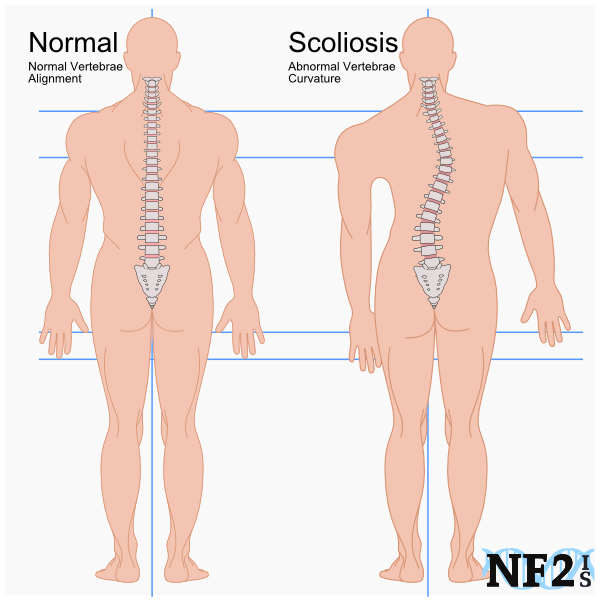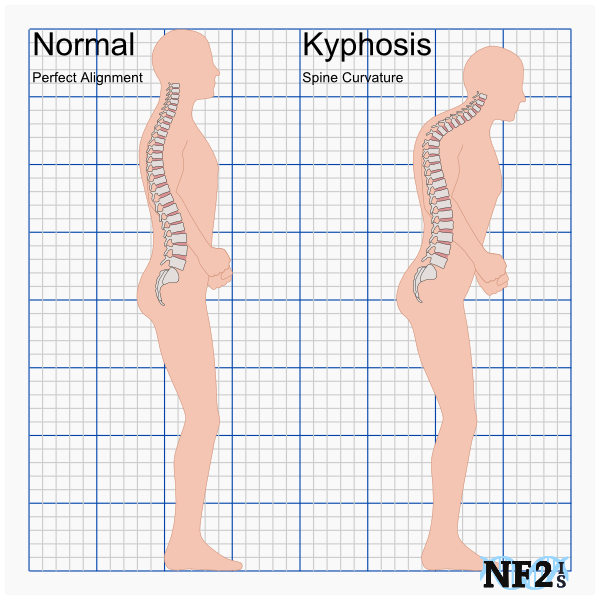Home > NF2 Facts & Information >
Skeletal Abnormalities
Last Updated: 01/23/25
Index
- Normal Spine Formation
- NF Skeletal Abnormalities
- Common Spine Deformities
- Issues
- Correcting Spine Curvatures
- Prevention
Also See
- Spine and the PNS
- Damage By Location - Peripheral Nerve System: Damage
Peripheral Neuropathy - Vitamin B12 - Healing Nerve Damage


The normal spine has a straight profile when seen from behind. Scoliosis occurs when a curvature deforms this profile, which may appear in one or more segments. This curvature is associated with rotation and wedging of the vertebrae. In addition to the spinal curvature, there may be the prominence of the thorax or asymmetry of the shoulders and pelvis.[Rolton, 2014]
1. Normal Spine Formation
The formation of the spine changes from birth until during our teen years. After that, the spine might start to become deformed, changing shape again as we age and the spine degrades. The rate of this degradation depends on how poor our posture is.
2. NF Skeletal Abnormalities
Skeletal abnormalities for NF1 are different than they are for NF2 and Schwannomatosis. NF1 Skeletal Abnormalities are complex and extensive issues that start at young ages, but for NF2 and Schwannomatosis Scoliosis is the result of tumor growth along the spinal cord that damage Vertebrae.[Widemann, 2014]
3. Common Spine Deformities
Neurofibromatosis Type II (NF2)
Vestibular Nerve Damage
Poor posture develops is a common issue as a result of the slow decline of the health of the vestibular nerve (balance nerve), but is often worse after, as a person relearns to walk. It is difficult to start complete recovery of balance while the nerve remains partially intact.
Over time this can result in Scoliosis, Kyphosis, and Kyphoscoliosis.
Efforts need to be taken to correct or stop this from happening as soon as possible.
Spine Tumor
Each spinal cord deformity is a possible spine occurrence due to the tumors that grow along the spinal cord. If there is tumor pressure on an individual vertebra or following the spine surgery to remove a tumor and vertebrae are then damaged, the Vertebrae higher up in the spinal column can easily compress and cause damage, resulting in poor spine curvature.
Neurofibromatosis Type I (NF1)
Week Bones / Abnormal Bone Growth Formation
The most common spine deformation types include Scoliosis, Kyphosis, and Kyphoscoliosis. Scoliosis is when compression results in a person's back shifting left or right. Kyphosis, the spinal cord compression, results in a person hunched forward. Kyphoscoliosis is when both Scoliosis and Kyphosis curvatures apply to the same individual.
4. Issues
The spinal cord might change if tumors grow along the spinal cord and cause pressure on the individual vertebrae or following a spine surgery to remove a tumor, and vertebrae are then damaged. This situation could result in a slow, dangerous alteration in the proper spine formation that could result in:
- Problems Walking
- Breathing Problems
- Back Pain
- Spinal Infection after Surgery
- Spine or Nerve Damage
5. Correcting Spine Curvatures
The sooner either a back brace is used and physical therapy starts, the better the chance of prevention of surgical methods. Surgical correction methods to fix this are themselves complex and might relieve some of the pain, but not all. Individual consultations with surgeons and physical therapists are the best course of action if this starts to develop and then progresses:
5.1. Back Brace
Each incorrect curvature of the spine has a different brace to wear to help correct the deformation.
5.2. Physical Therapy
There are a variety of exercises that can be done to help manage different spine curvatures. Some can be done sitting, standing or lying flat.
If spinal cord issue is from Vestibular Nerve damage, immediate action to start physical therapy of Vestibular Balance Recovery (VRT) should be considered.
5.3. Surgery
When spinal cord abnormalities start to develop, it is ideal to do everything possible to prevent the need for surgical options.
- Removing Vertebrae
- Spinal Fusion
- Placement of Hooks, Screws, and Rods
- 3D Printing for Titanium Supports: 3D printed Casts, molds for Titanium, for individual specific Vertebrae supports. 3d printing can make any shape and new technologies with 3d imaging from MRI can allow for development of proper shaped supports better than current method of Hooks, Screws and Rods.
Spinal fusion also known as Spondylodesis or Spondylosyndesis is a method to connect two or more vertebrae. This method requires a bone graft to connect the vertebrae. A bone graft might be from other bone in the individual like the hip, donor bone, or a synthetic ceramic material.
Since these implanted pieces would not be the exact shape needed, to help create the right shape and bind the new bone to the existing spine completely, a calcium porous putty substance is used in the process, which adapts over time to become bone matter.
These can be used to help limit excessive movement and fix spine deformation and might be placed in or between several vertebrae as needed.
As of today, May 2017, 3d printed casts may not have been used for more than two (2) people.
6. Prevention
Prevention is important even if there are options to manage the damage if necessary as the surgical options have considerable risks.
Some prevention methods include:
- Keep your Head Back
- Avoid Slouch when Walking
- Sit up Straight - Square Shoulders
- Take Breaks from Sitting
- Stretch - hands up and touch toes (as well as you can)
- Exercise Regularly (walking and building core muscles)
- Yoga - Discuss practical yoga positions, and positions to avoid with your doctor.
7. Reference Sources
- Rolton, D., Nnadi, C., & Fairbank, J. (2014). Scoliosis: a review. Paediatrics and Child Health, 24(5), 197-203. http://www.sciencedirect.com/science/article/pii/S1751722213002382
- Widemann, B. C., Acosta, M. T., Ammoun, S., Belzberg, A. J., Bernards, A., Blakeley, J., ... & Morrison, H. (2014). CTF meeting 2012: Translation of the basic understanding of the biology and genetics of NF1, NF2, and schwannomatosis toward the development of effective therapies. American Journal of Medical Genetics Part A. http://onlinelibrary.wiley.com/doi/10.1002/ajmg.a.36312/full
- "Doctors implant 3D-printed vertebrae in 'world's first' surgery" (2016) https://www.engadget.com/2016/02/25/doctors-implant-3d-printed-vertebrae-in-worlds-first-surgery/


 |Google Play
|Google Play